Category: Hunting Blog
Hunting The Second Chase Phase of the Rut
Last week I wrote about the lockdown phase of the rut. That phase of the rut can be some tough hunting as mature bucks don’t travel much except when finished tending one doe and seeking another receptive doe. Does tend to remain receptive (in heat) for approximately 24-36 hours.
However, during the next few days whitetails throughout most of their range will enter the second chase phase of the 2011 rut. This occurs when most of the does have been bred and bucks are seeking a receptive doe after a few weeks of finding such a doe almost daily. A huge factor in the length of the lockdown phase at any location is the adult sex ratio.
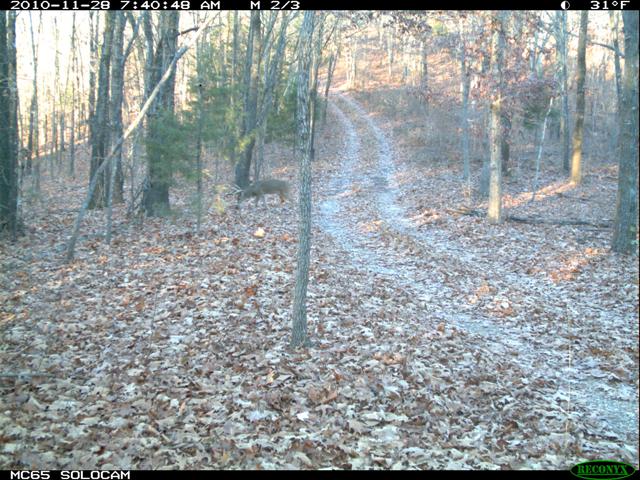
Buck during second chase phase of the rut
If the adult sex ratio favors does, then bucks don’t have to search as much or compete for receptive does. Some does won’t be bred during their first receptive cycle and will become receptive again in approximately 28 days. Often the phases of the rut in these herds are not well defined.
If the adult sex ratio favors bucks (can be accomplished in herds where more does are harvested than mature bucks), then the lockdown phase usually only lasts about two weeks and there is intense competition for the receptive does. The second chase phase in such herds can be almost as good as the pre breeding chase phase.
There are two factors that dampen the second chase phase. The first is some of the bucks have been killed by hunters, predators, suffered injuries from fighting, etc. There are simply less bucks to harvest during the second chase phase compared to the first.
The other factor is that bucks have now been pressured for several weeks. They are proven skilled at avoiding hunters if they are alive during the second chase phase. These bucks are not easy to pattern or kill.
However, there are some advantages to hunting the second chase phase. There is usually less food available during the second chase phase. Hence, identifying the food source is easier than during the early fall. Likewise the days are usually colder and deer need more calories. Therefore, they will spend more time feeding each day. This is when quality late winter season food plots can be great stand locations!
I’ll be using my Reconyx trail cameras to see which bucks on my hit list are still alive, and which food plots the does are using. Then, I’ll hunt the travel corridors or the actual plots that deer are feeding in frequently in an effort to tag another mature buck this year.
My strategy for the chase phase led to the harvest of Clean 12. I look forward to seeing if this strategy leads to the harvest of another mature buck.
Growing (and hunting) Deer together,
Grant
Lockdown Rut Phase
I grew up hearing and thinking the rut was the best time to hunt big bucks! Like most subjects, the more you learn, the more you use the terms “however,” “but,” and “if.” As I learned more about hunting and deer biology, the term “rut” got replaced with “pre-rut,” “the chase phase,” “lockdown,” and “post rut.” As I began understanding the facts and theories about these phases of the rut, I learned just how much site specific deer management impacts the behavior of local deer herds.
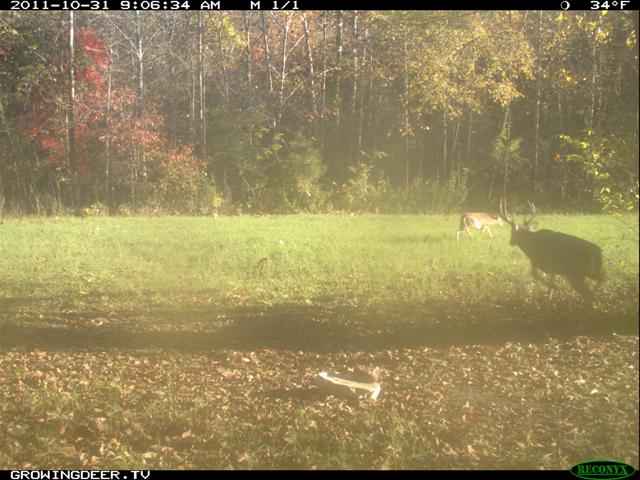
Big, mature buck chases a doe during chase phase of the rut.
I live and do most of my hunting in southwestern Missouri. In fact, I hunt primarily in Stone and Taney counties of Missouri. No matter where you hunt, herds with a higher number of mature bucks in combination with a balanced adult sex ratio usually provide better deer hunting. Bucks in these herds tend to respond to rattling, grunt calls, decoys, etc., better. There seems to be more activity during daylight hours (given the same weather conditions).
The best hunting is where a balanced adult sex ratio and older age structure exists among bucks for a large geographical area. The larger the area the better! However, the quality of hunting (as far as interacting with deer expressing all phases of the rut ) can be improved. Even on smaller acreages where deer ranges tend to overlap the property lines on neighbors that still practice “if it’s got horns, shoot it.”
In that scenario, the best hunting is usually during the later stages of the pre-rut or the chase phase of the rut. This is when bucks are searching for does, but the does are not receptive yet. Therefore, the bucks tend to be on their feet more hours throughout the day.
When a majority of the does are receptive, many of the bucks (young and old) will be paired up with a receptive doe for 24-36 hours. Often times a dominate buck will stay within 10 yards of a doe while subordinate bucks stay in the area trying to sneak in for a date. Does rarely move much in this situation, so the bucks don’t cover much ground either. When the peak of breeding is occurring, hunters are less likely to see deer.
I’ve heard from several of my hunting buddies from South Carolina to Kansas during the past few days and none of them are reporting seeing many deer. It appears many deer herds are currently in the lockdown phase of the rut.
I’ll keep hunting, but I’m looking forward to the post rut when once again just a few does are receptive and mature bucks are cruising trying to find a date and feeding. There’s another peak of mature buck activity coming and I’m eagerly waiting. I’ll share with you what I know from a hunter’s and scientist’s point of view next week.
Growing Deer Together,
Grant
The Chase Phase of the Rut
Mature bucks are beginning to chase does throughout much of the whitetail’s range. It’s a time of year that literally millions of deer hunters schedule their vacation and with good reason.
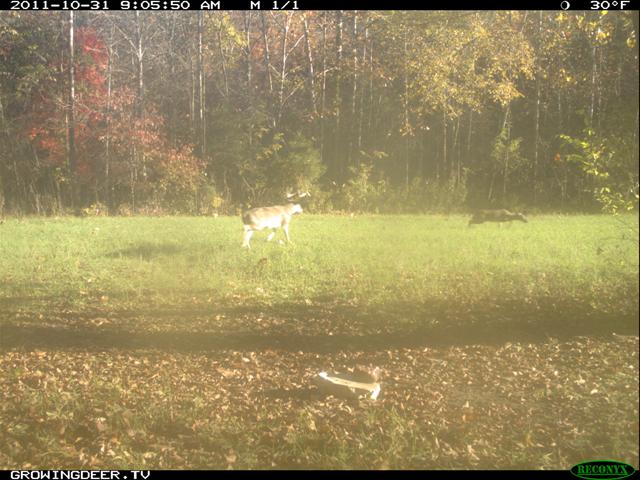
A big, mature buck chases a doe
If you hunt close to home, you can pick days to hunt when a weather front is passing, or you’ve found a limited resource such as a pond during drought that deer are actively using. However, if you are traveling to hunt then the chase phase allows you to plan a year in advance and puts the odds in your favor that mature bucks will be active during daylight hours. During the chase phase of the rut mature bucks tend to be active during the daytime even if the hunting pressure or air temperatures are a bit higher than normal.
The October Lull phase of deer activity just passed. This is when deer, especially mature bucks, have grown their winter coat and food is usually plentiful. Deer don’t have to travel far to find food, and they aren’t burning many calories to stay warm or chase does. Mature bucks simply don’t have many reasons to move during daylight in mid-October in most regions.
However, with each passing day now more and more does will become receptive. Bucks will be moving in search of the few does that are receptive. For the next several days, more and more does will become receptive until the peak of breeding activity. During the peak of breeding activity, most mature bucks will stay with a receptive doe for about 24 hours. This is called the Lock Down phase of the rut. During this time, mature bucks typically only move when they are finished tending one receptive doe and are seeking another.
The woods can seem almost void of deer during the Lock Down phase. This is because it’s not only the mature bucks that tend does. In fact, multiple research projects have now shown that mature bucks only breed slightly more does annually than immature bucks. Not many deer will be moving when most of the does are receptive and most of the bucks can have a date.
In addition, the duration and intensity of each phase of the rut varies location by location based on the herd’s adult sex ratio and health. Herds with a balanced (or skewed toward bucks) adult sex ratio seem to have the most intensive rutting behavior. There’s much more to the science than what I’ve shared here.
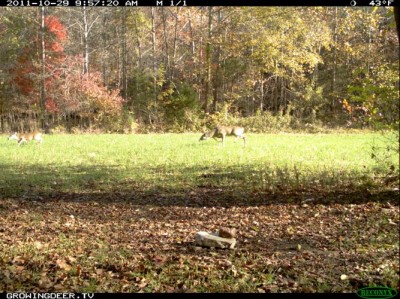
A Buck Chasing A Doe During The Chase Phase of the Rut
So, if you enjoy hunting the chase phase of the rut, get out the door! It’s time to go hunting! If you choose to plan ahead for your hunting vacation next year, the first and second week of November is usually a good option for hunting mature bucks in most areas of the whitetail’s range. There are other times of the year that can be very productive, but they are very weather dependent. The local weather can’t be predicted accurately enough to plan vacation time months ahead. However, weather isn’t as big of a factor during the chase phase of the rut, so it’s the safest bet for scheduling hunts that require packing a suitcase!
Growing Deer together,
Grant
It’s Time to Rattle!
The pre-rut is happening now throughout much of the whitetail’s range! My Reconyx cameras have taken more images of mature bucks during daylight hours during the past few days than any week since last fall! It’s prime hunting time!
Most does are not receptive yet. However the bucks are ready and eager for a date! They are actively seeking, and therefore very responsive to calls! Bucks may respond to calls at any time during the season, but they are most likely to respond during this stage of the rut.
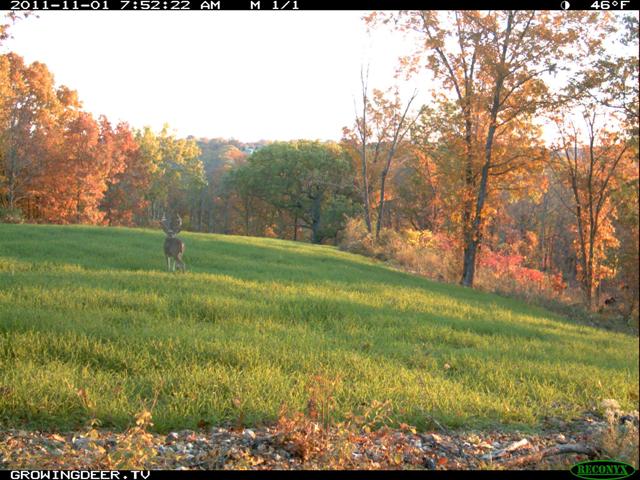
A grunt call is your best choice when a mature buck is nearby.
A fellow biologist and friend of mine, Dr. Mick Hellickson, is both a skilled hunter and researcher. Years ago he designed a study to determine how to rattle to get the most bucks to respond. He and his team tested four different rattling techniques in an area where several bucks were fitted with radio collars. They used the following sequences:
- Short duration and low volume
- Short duration and high volume
- Long duration and low volume
- Long duration and high volume
They had significantly more responses to the long duration and high volume sequence. This is easy to understand. Do you remember watching fights during school? If it was a relatively quiet scuffle between two freshmen, few folks even stopped to watch. Certainly no one even knew to run down the hall and watch.
However, if it was two seniors fighting to gain the attention of the prom queen, there was usually lots of yelling, lockers being rattled, grunts, and moans. It was so loud that most folks in the school ran to watch the fight. Even folks that were not involved with either party came to watch the fight!
The same is true when bucks fight. Yearlings tend to spar, scuffle, and not make many vocalizations when they “fight.” When you were a freshman in school and got into scuffle you probably didn’t want to draw the attention of a big senior or he might decide to settle both of the freshmen in the scuffle down.
However, when the big seniors got into a fight, part of the victory was knowing that everyone was watching!
When I rattle to call deer and no deer are in sight, I want to be a senior! I make as much rattling noise as I can!! I grunt or grunt snort wheeze. I then rattle making as much volume with the tool (antlers, rattle bag, etc.,) as I can. If practical and safe, I use my foot to shake a limb while I’m rattling. I want everyone in the school to know the big boys are fighting!
I don’t do this if I know there is a mature buck close by. This will likely alert him to my exact position. I use this type of calling technique when blind calling or calling when I don’t believe a deer is close by. If I do think a buck is close by, I will often simply grunt lightly and keep increasing the volume until the buck responds. I used the technique last week to call in Clean 12 – a buck that appeared he was going to pass by my stand at 70 yards and was headed to a bedding area (GDTV 101). A simple grunt resulted in Clean 12 making a scrape, rub, vocalizing a snort wheeze and approaching to within three yards of my stand.
Rattling is a great technique to attract mature bucks from a long distance. However, deer are very good at pinpointing the exact location of a call. Therefore they often will approach from the downwind side. This is why I don’t use the loud rattle sequence frequently. I want the buck to hear it once and come searching for the fight participants. I don’t want him to have the opportunity to hone in on the exact location.
My strategy on rattling is probably best summarized by a line in an old movie (I forgot the name of the movie) that goes “If you are going to be a bear, you might as well be a griz.” If you are going to rattle in hopes of calling in a buck when no deer are in view of the stand, make as much noise as you can. You want the bully buck in that area running in to see who is fighting on his turf.
Growing (and calling) Deer together,
Grant
Patterning A Mature Buck
I grew up rabbit hunting. It was the game of choice as there wasn’t a deer season in the county where I was raised. One of my favorite pastimes was tracking or back tracking rabbits in the snow. I probably learned more about rabbits and rabbit hunting by back tracking rabbits in the snow than I did from anything else with the exception of invaluable lessons from my grandfather and father (they were incredible rabbit hunters). In hindsight, those lessons were of huge value to me as a deer biologist and hunter. I learned that critters need food, cover, and water and will use the path of least resistance to move from one to another AS LONG AS THEY DON’T FEEL THREATENED ALONG THOSE PATHS.
The same is true for mature bucks. They need food, cover, and water on a regular basis and will move between these resources along the path of least resistance as long as they don’t feel threatened. One of my hunting tactics is to determine if there are mature bucks in the area by using Reconyx cameras and then use aerial photos to locate the likely sources of food, cover, and water close to the camera that photographed the buck. Notice that I didn’t say I moved the camera to monitor the sources of food, cover, and water. One of my keys to success is being very aware of the bold words in the previous paragraph – AS LONG AS THEY DON’T FEEL THREATENED ALONG THOSE PATHS.
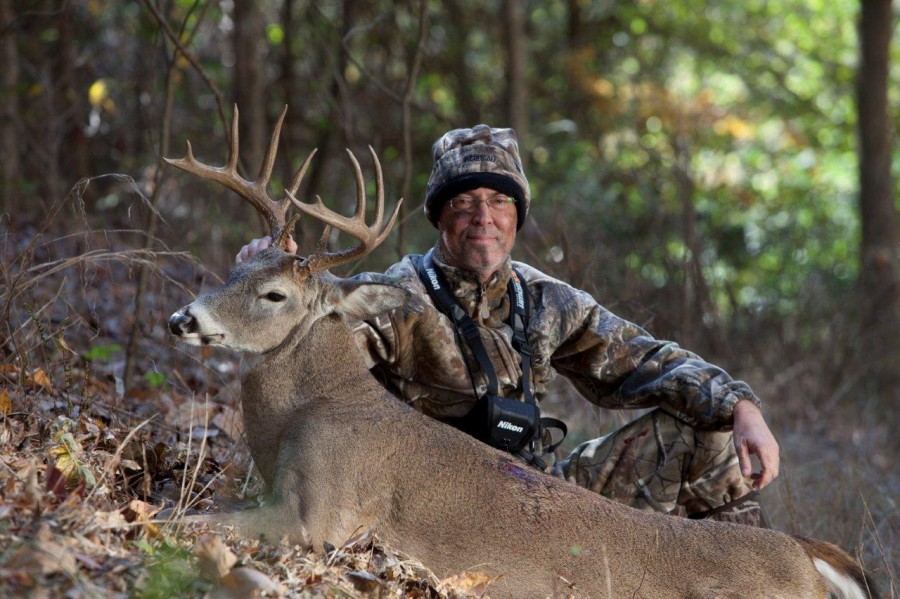
Most of my neighbors hunt and deer are constantly being alerted during the season in my neighborhood. I know deer will range off my property. However, I want to encourage them to spend as much time on my property during daylight hours as possible. That’s one reason why I created sanctuaries! Deer, even during the rut, will likely spend most of the day resting in thick cover. If I can protect bucks during the day, they will have a good chance of surviving to maturity. In addition, if mature bucks are conditioned to finding safety in the same area (sanctuaries), then it’s easier to pattern them.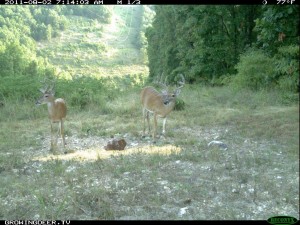
I used this strategy last Friday to kill a buck I had named Clean 12. It was a great hunt as I watched the buck for more than 10 minutes including watching him make a scrape, thrash some limbs with his antlers, and vocalize a snort wheeze. I ended up shooting Clean 12 at three yards! It was a thrilling hunt!! However, what made this encounter with Clean 12 work was simply applying the strategy outlined above.
I had obtained several Reconyx images of Clean 12 during the late summer. I placed some Reconyx cameras in open areas such as Trophy Rock stations and food plots to get a feel for his range and travel patterns.
I knew I wouldn’t likely hunt at any of those camera stations 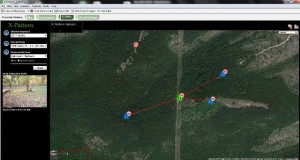 because they were in open areas. Mature bucks would rarely visit them during daylight once season opened. I then used my knowledge of the closest locations for food (used mainly at night by mature bucks this time of year), water (several springs and seeps in the area so no way to predict which source he might use), and cover.
because they were in open areas. Mature bucks would rarely visit them during daylight once season opened. I then used my knowledge of the closest locations for food (used mainly at night by mature bucks this time of year), water (several springs and seeps in the area so no way to predict which source he might use), and cover.
Years ago I had created a sanctuary at the east end of the area where I had images of Clean 12. It seemed the obvious bedding area for Clean 12 . It was the most limiting of three needs a deer has daily (food, water, and cover) in the portion of his range I had confirmed. In addition, I could approach from the east and not enter the area where I had patterned him mainly at night. A northwest, west, or southwest wind would be perfect for the area between where I knew Clean 12 was using and the sanctuary. This area is a de facto transition zone. Deer shouldn’t feel threatened moving into the sanctuary so the site I picked to hang my Muddy stands was the path of least resistance. Finally, the sanctuary was lower in elevation than the ridge where I had determined Clean 12 was using at night and the thermals would be pulling scent downhill (east) and away from where I predicted Clean 12 would be coming from toward the sanctuary.
With my plan in place, Adam (my cameraman) and I were able to approach our stands without alerting deer anywhere to the west of us. About 9 am, I spotted a buck 70 yards away moving toward the bedding area. The habitat work, placement of the Reconyx cameras, and Muddy stands had paid off. You can see the events that occurred when Clean 12 closed the last 70 yards on GDTV 101.
Growing (and hunting) Deer together,
Grant
Big Bucks and Late Frost
Most of my hunting buddies throughout the whitetails range are talking about the slow start to the 2011 hunting season. Sure there have been some great bucks harvested, but the season seems slow overall. I was hunting yesterday and watched a yearling and a two year old buck work a scrape. However, I’m not seeing as many scrapes as normal for this time of year. Scrape behavior is not the only thing that is late this fall. It hasn’t frosted yet in southern Missouri, Kentucky, etc. The normal frost date for that latitude is about October 10-15. There is no frost predicted in the seven day forecast. It seems there is usually a burst of deer (and deer hunter) activity when the first strong cold front occurs.
There is not a tested and proven scientific reason to why deer tend to move more when the first strong cold front occurs each fall. However, I think it is as simple as deer having their winter coat and not being as comfortable moving when the air temperature is warm. In addition, before the first frost, many forage plants are still growing which means there are multiple sources of food. Once the temperatures decrease significantly, I suspect it is more comfortable for deer to be active. In many areas, they will have to search for food more as some sources of forage were killed or became unpalatable after the frost. I want the bucks where I’m hunting to feel the need for more fuel. For this reason and more, I always welcome the first frost.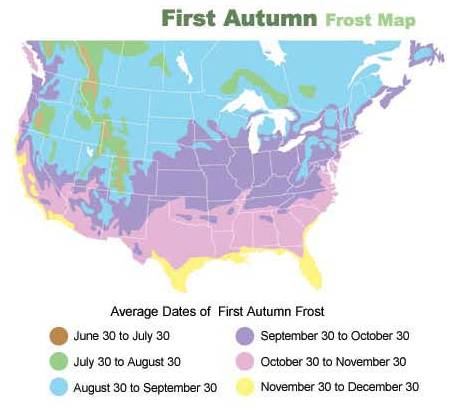
On the other hand, it has recently rained at my place. The wheat I had planted has germinated and grown some, but not much. Another week without a frost will allow the wheat to produce many more pounds of forage. That will make for some great hunting later this season and provide more high quality forage for the local deer herd. So from that point of view, I’m glad it hasn’t frosted yet.
I’ll go hunting whether it frosts or not. However, I don’t plan to hunt my best stand locations until a weather change occurs and I believe daytime deer activity increases. It’s always tough to schedule a vacation to hunt a critter whose daytime activity level is so tied to the weather – which can’t be accurately predicted more than a few days in advance.
When the first cold front occurs, I suspect I’ll stop hearing from some of my hunting buddies. They will be too busy hunting to visit – and so will I.
Growing Deer together,
Grant
Deer Movement Related to Weather
After 20+ years of collecting data as a scientist and as an avid deer hunter, it’s obvious that hunters see more deer when the weather is changing. The trends show that the more abrupt the changes in weather, the more likely hunters are to see deer.
My most memorable observation related to deer and changing weather occurred during September 1989. I was studying deer behavior associated with rubs near Charleston, South Carolina. Hurricane Hugo was predicted to come on shore and the storm’s eye was to pass within miles of my study site. While I was making one last round to check the cameras used to monitor the rubs before the storm, I saw mature bucks, does, and fawns literally everywhere during the day. I saw them in fields, in food plots, in yards – everywhere. I had permission to hunt the property where I was doing research, but thought the power might go out for a day or two and opted not to harvest a deer. The eye of the storm almost center-punched the property where I was working and electricity wasn’t restored for six weeks.
Unquestionably the deer sensed the magnitude of the coming change in weather better than me. Rather than thinking about hunting, I should have been driving out of the storm’s path! No one knows how deer sense a pending change in weather. Several researchers, including myself, have attempted to understand how deer detect pending changes in weather. No researcher has published a definitive reason why deer increase activity substantially before or after some substantial changes in the weather.
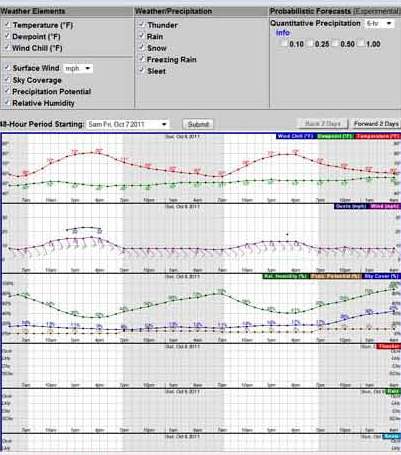 Weather can’t accurately be predicted more than a few days (or hours) in advance. I know this all too well as I prepare today to return from a hunting trip in Kansas. I planned this trip months ago. I’ve spent the better part of this week thinking about this as the weather has been hotter than normal (setting some records), very low humidity, and extremely dry. I’ve seen a few does and fawns daily, but no mature bucks. The owner of the property where I’m hunting told me yesterday that he didn’t have a single trail camera image of a mature buck moving during the daytime this past week. He did say “You should have been here last week.” Dang, I really dislike hearing that phrase in relation to hunting!
Weather can’t accurately be predicted more than a few days (or hours) in advance. I know this all too well as I prepare today to return from a hunting trip in Kansas. I planned this trip months ago. I’ve spent the better part of this week thinking about this as the weather has been hotter than normal (setting some records), very low humidity, and extremely dry. I’ve seen a few does and fawns daily, but no mature bucks. The owner of the property where I’m hunting told me yesterday that he didn’t have a single trail camera image of a mature buck moving during the daytime this past week. He did say “You should have been here last week.” Dang, I really dislike hearing that phrase in relation to hunting!
I enjoy hunting and visiting with friends. However, my mission was to pattern and harvest a mature buck. I think I patterned the activity of mature bucks in this part of Kansas – moving almost exclusively at night. I could have predicted this activity pattern based on the weather. I simply couldn’t predict the weather months in advance. Often, when planning hunting trips, the biggest limiting factor in the equation is that the weather at a specific location can’t be predicted with any degree of accuracy.
I enjoy hunting new areas, learning the lay of the land, etc. I enjoy taking off from the truck with nothing except my bow, a stand and a map. However, I’d probably enjoy it more if the weather was changing to conditions favorable for mature bucks to be active during daylight hours. I’ll hunt again this morning, and then pull my stands and head home. The weather is clear, dry, and warm – perfect for driving. I couldn’t have planned that part better!
Growing Deer together,
Grant
Deer Hunting and Scent Control: How Good is a Deer’s Nose?
Most hunters know that deer have a great sense of smell. However, it is very difficult for researchers to determine just how good a deer’s sense of smell is. We can’t put samples in front of a deer and ask them if they can detect this odor or chemical. However, earlier this week I indirectly witnessed an example of how well deer can smell.
I shot a doe in the liver with my bow. I reviewed the footage on a high quality HD camera (we were filming for GrowingDeer.tv). I knew the hit would be fatal, but the trailing job would be a bit longer than a deer shot in both lungs. We waited an hour then took up the trail, which was easy to follow for the first 100 yards. The doe then traveled through a grove of cedars and blood doesn’t show up very well on cedar needles. In Missouri, all possible means to recover a deer must be used before using a dog to trail. I felt we were at that point so I called the local conservation officer and obtained permission to use Crystal, our 18 month old lab. Tracy, my wife, has been training Crystal to follow blood trails.
Crystal was a bit confused at first given all of my scent, but eventually she picked up the trail. She trailed the doe through the cedars, across a food plot, across a dry creek, through chest high weeds along the creek, down a gravel road for 100 yards, then 50 yards into a thick bedding area. I was thrilled to see the doe piled up and gave Crystal several treats and plenty of “good girl” comments!!
Besides being thrilled to recover the doe, I was once again shown how well deer can smell. It’s generally assumed that prey species (deer included) have as good, if not a better, sense of smell than predator species (Crystal included). This is one reason prey species are able to survive.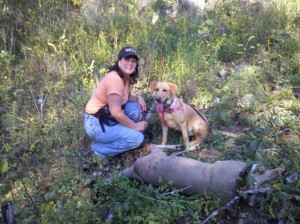
Several vehicles had driven the gravel road between when I shot and when Crystal trailed the doe down the gravel road. The humidity was low that day and because gravel is not porous it is not a good surface to hold scent. The gravel had been covered by vehicle exhaust, dripping oil, etc. Neither I, nor the folks helping, saw one drop of blood on the gravel road. Simply stated, Crystal was able to trail the deer in horrible conditions.
I share this event to illustrate how good a deer’s sense of smell is. It’s incredible! Based on this and gads of other similar observations, my hunting strategy has changed over the years to include reducing as much scent from my gear and myself as much as possible.
I start with a shower. I then dry myself with a clean towel that’s been laundered in scent free soap. My hunting clothes have been laundered with scent free soap also and stored in a barn that doesn’t have gas, etc., stored close by. I take my hunting clothes and gear to the field in clean tubs and change into them beside my truck just before I walk to my stand. Yes, it can be wicked cold changing in the field during the late season. I have a pair of boots I only use when I hunt. I never wear them inside my truck, let alone to go shopping, get gas, etc. I use the Dead Down Wind system because it is based on enzymes that destroy chemicals and bacteria that are the source of odors. Most scent control systems are only a bactericide – just one source of odors.
The effort involved to take these steps is worth it to me as I frequently watch deer cross the path I use to access my stand. In fact, I watched multiple deer cross the path the cameraman and I used to access my stand this past Wednesday, when I harvested two does. Multiple deer fed 270 degrees around the stand without giving any indication they smelled Adam (the cameraman), me, or our gear. It was a beautiful morning in the woods watching deer and bringing home some venison. I believe it occurred because Adam and I use a simple, but effective scent reduction system.
A deer’s sense of smell is amazing. However, by reducing the scent on me and my gear as much as possible by using a complete system, I have shown that I can keep from alerting deer to my presence. This is critical in the humid, swirling wind conditions where I live and hunt. During bow season, controlling my scent enough that deer may approach 10 yards closer can lead to more opportunities to draw back my bow.
I like watching Crystal work, but would rather watch her trail someone else’s deer. I’ll keep using my system and let my buddies know Crystal is available if they make a bad hit.
Growing Deer together,
Grant
Nocturnal Bucks
There is a buck at my place I call Pitch Fork. His rack has been odd shaped for the last three years that I have been tracking him. Actually without genetic testing, it is never 100% certain that a buck with a similar rack is the same from one year to the next. However, I feel very confident that the buck I called Pitch Fork in 2009 is the same buck I called Pitch Fork in 2010 and 2011.
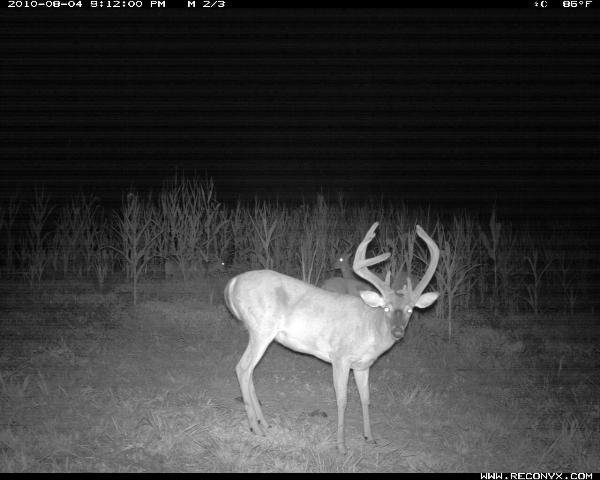 Not only has his rack remained in the same basic configuration, but his behavior hasn’t changed. He’s extremely nocturnal. My Reconyx cameras have taken images of Pitch Fork at the same three locations (relatively close together) for three years. Every Reconyx image of Pitch Fork is at night – every single one. The closest I’ve come to seeing Pitch Fork was last spring, when we found one of his shed antlers during our 2011 Shed Hunt.
Not only has his rack remained in the same basic configuration, but his behavior hasn’t changed. He’s extremely nocturnal. My Reconyx cameras have taken images of Pitch Fork at the same three locations (relatively close together) for three years. Every Reconyx image of Pitch Fork is at night – every single one. The closest I’ve come to seeing Pitch Fork was last spring, when we found one of his shed antlers during our 2011 Shed Hunt.
Pitch Fork is a buck that is high on my hit list simply due to his age and my frustration factor with him. I believe I know his core area from the images, finding of a shed, etc. However, I’ve never seen this buck during daylight while hunting (or simply working the land). 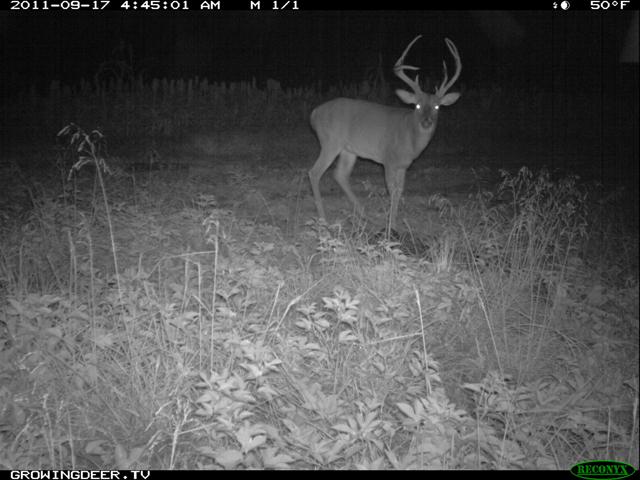 It seems he only moves at night.
It seems he only moves at night.
I’ve known of several bucks through trail camera and GPS collar studies that seemed almost unkillable using legal methods. However, even the most nocturnal of these bucks will move sometime during the daylight.
Like many of you, I can’t hunt every day. So, as much as I enjoy a challenge, I focus my hunting effort on mature bucks that show more sign of moving during the daylight hours based on observations and images from my cameras. Although I focus my hunting effort on mature bucks that are captured on trail cameras more during daylight, I am vigilant for chinks in the armor of nocturnal bucks like Pitch Fork. This strategy has proven successful for me on several occasions
If you are a hunter that enjoys attempting to pattern and hunt for specific bucks, be careful of which bucks you place on your hit list. Nocturnal bucks like Pitch Fork can lead to years of frustration. However, studying bucks like Pitch Fork can make you a better hunter. Such bucks have very few holes in their predator survival plan. Pitch Fork has taught me many lessons during the past three years. I’ll find out how much I learned when I hunt him this year. I’ll let you know my grade later this season.
Growing (and hunting) Deer together,
Grant
When to Harvest Does
Every year at this time I am frequently asked “When is the best time to harvest does?” This is not to be confused with the question “Should I harvest does?” Whether to harvest does or not should be based on the goals of the land owner and the balance of deer numbers and the habitat’s ability to produce/provide quality forage throughout the year. The more of deer’s genetic potential the land owners desire to be expressed the more important it is for each deer to have access to all the quality forage they will consume year round. I suspect that 99.9% of the problems folks perceive to be attributed to genetics with deer can be solved by providing better quality nutrition.
Once the doe harvest quota has been established, the best time to begin harvesting does is the first opportunity presented during legal hunting season!! There are several arguments that are commonly used against this strategy but the most common seems to be “the bucks will leave seeking does elsewhere.”
This is simply not true for the majority of mature bucks. I refer to Queen Isabella I to illustrate this point. Queen Isabella funded Columbus’ mission that resulted in discovering North America. Queen Isabella thought the world was flat. Columbus thought the world was round – that something better was past the area that was in current range.
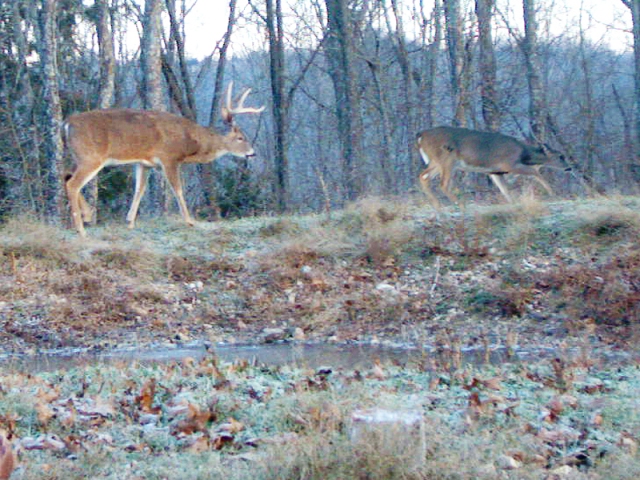 Based on tens and tens of thousands of points recorded by GPS collars on mature bucks, bucks share Queen Isabella’s theory that their world is flat and it is very dangerous outside of their known world. They have no idea if there are more or less does outside of their range. They certainly don’t know the wind thermals, threats, predators, hot spots, etc., outside their range. Most mature bucks that have been fitted with GPS collars from Texas to Minnesota to Maryland to Florida spend all or the vast majority of their days within the same home range. Some of these collared bucks have taken excursions and almost always return to their range in 24 or 48 hours. By any measure, mature bucks are homebodies.
Based on tens and tens of thousands of points recorded by GPS collars on mature bucks, bucks share Queen Isabella’s theory that their world is flat and it is very dangerous outside of their known world. They have no idea if there are more or less does outside of their range. They certainly don’t know the wind thermals, threats, predators, hot spots, etc., outside their range. Most mature bucks that have been fitted with GPS collars from Texas to Minnesota to Maryland to Florida spend all or the vast majority of their days within the same home range. Some of these collared bucks have taken excursions and almost always return to their range in 24 or 48 hours. By any measure, mature bucks are homebodies.
Based on all we know about deer and their use of senses and their ability to survive this makes sense. Deer would be extremely vulnerable to predators (2- and 4-legged) without great knowledge of the habitat and wind thermals.
To make bucks more active during the rut within their home range, it is best to reduce the number of does so each mature buck will search more to find a receptive doe. If the adult sex ratio is skewed toward does, a mature buck may spend most of his time “locked down” with a receptive doe and not be cruising/competing for a date.
I’ve experienced the benefits of hunting properties where the adult sex ratio was balanced or even skewed toward bucks. The rut was intense!! Grunting, rattling, and using other vocalizations often results in action when used in herds with a balanced adult sex ratio. I’ve witnessed this throughout the whitetails’ range. You can experience it also – if you begin harvesting does early and work toward your harvest objective. The number of does to harvest will vary from none to many, depending on the habitat’s capacity to produce quality forage and the herd’s current adult sex ratio.
Finally – every year I witness club and land owners adopt the strategy of waiting until after the rut to begin harvesting does. They rarely meet their doe harvest quota and their hunting isn’t as good because those does they passed got a date with a mature buck and caused him to be locked down for a couple of days. Ten extra does could mean 20 days of some mature bucks being locked down.
With that, I’m out the door to hunt. It’s the second day of bow season and I haven’t tagged a doe yet. I need to tag a doe tonight so my hunts during the rut will be exciting this year.
Growing Deer together,
Grant



